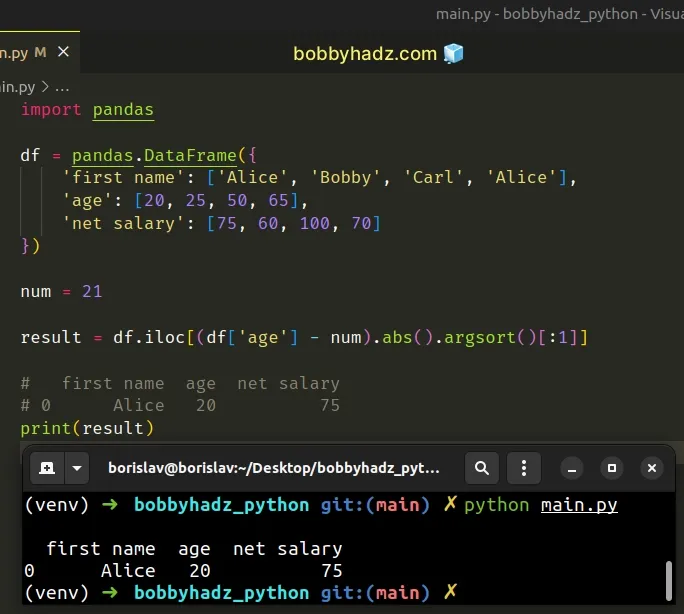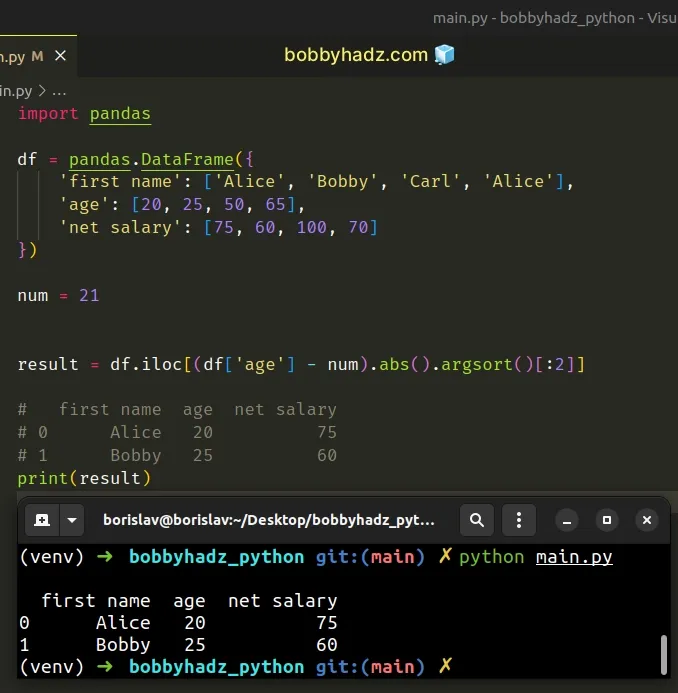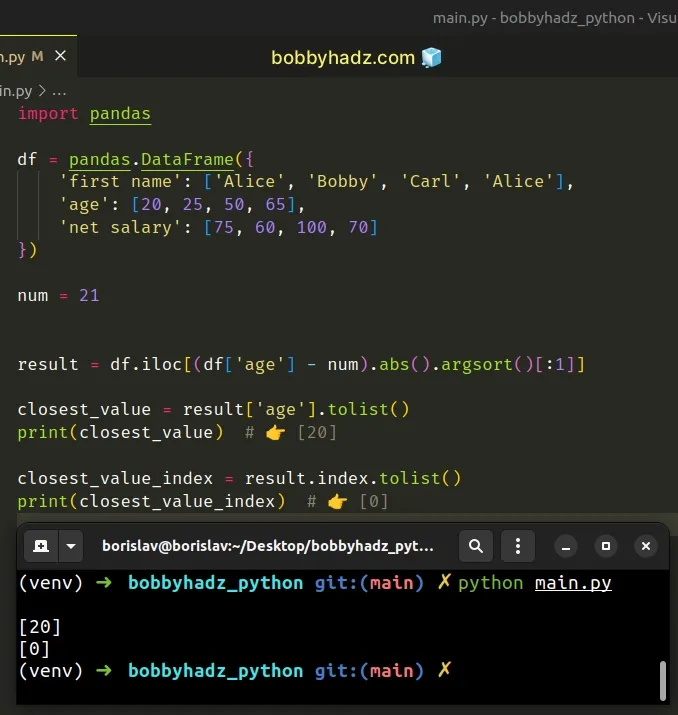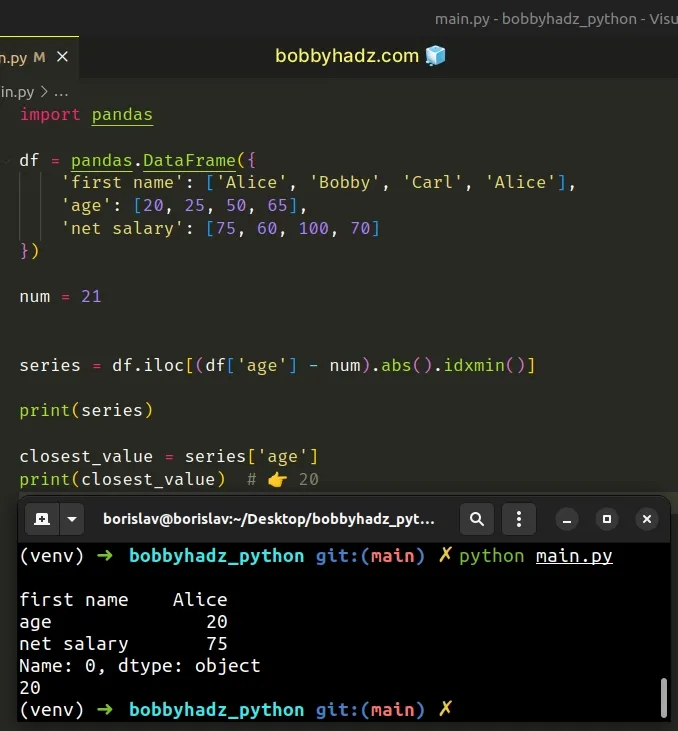Pandas: Find the closest value to a Number in a Column
Last updated: Apr 12, 2024
Reading time·3 min

# Table of Contents
- Pandas: Find the closest value to a Number in a Column
- Find the index of the closest value in a Pandas DataFrame column
- Find the closest value in a DataFrame column using idxmin()
# Pandas: Find the closest value to a Number in a Column
To find the closest value to a Number in a DataFrame column:
- Subtract the number from each value in the given column.
- Use the
argsort()method to get the integer indices that would sort theSeries. - Select the element at the first index.
import pandas df = pandas.DataFrame({ 'first name': ['Alice', 'Bobby', 'Carl', 'Alice'], 'age': [20, 25, 50, 65], 'net salary': [75, 60, 100, 70] }) num = 21 result = df.iloc[(df['age'] - num).abs().argsort()[:1]] # first name age net salary # 0 Alice 20 75 print(result)

The code sample selects the closest value to the number 21 in the age column
of the DataFrame.
We first subtract the given number from each value and get the absolute (non-negative) result.
import pandas df = pandas.DataFrame({ 'first name': ['Alice', 'Bobby', 'Carl', 'Alice'], 'age': [20, 25, 50, 65], 'net salary': [75, 60, 100, 70] }) num = 21 # 0 1 # 1 4 # 2 29 # 3 44 # Name: age, dtype: int64 print((df['age'] - num).abs())
The next step is to use the
Series.argsort()
method to get the integer indices that would sort the Series values.
import pandas df = pandas.DataFrame({ 'first name': ['Alice', 'Bobby', 'Carl', 'Alice'], 'age': [20, 25, 50, 65], 'net salary': [75, 60, 100, 70] }) num = 21 # 0 0 # 1 1 # 2 2 # 3 3 # Name: age, dtype: int64 print((df['age'] - num).abs().argsort())
In order to get the single closest value of the given number, we select element
at the first index (0).
result = df.iloc[(df['age'] - num).abs().argsort()[:1]] # # first name age net salary # # 0 Alice 20 75 # print(result)
If you want to get the closest value as a literal, instead of in a DataFrame,
access the column and use the Series.tolist() method.
import pandas df = pandas.DataFrame({ 'first name': ['Alice', 'Bobby', 'Carl', 'Alice'], 'age': [20, 25, 50, 65], 'net salary': [75, 60, 100, 70] }) num = 21 result = df.iloc[(df['age'] - num).abs().argsort()[:1]] print(result['age'].tolist()) # 👉️ [20] print(result['age'].tolist()[0]) # 👉️ 20
The
Series.tolist()
method returns a list of the values stored in the Series.
If you want to get the first N elements, use a different slice.
For example, the following slice selects the closest 2 values of the given number.
import pandas df = pandas.DataFrame({ 'first name': ['Alice', 'Bobby', 'Carl', 'Alice'], 'age': [20, 25, 50, 65], 'net salary': [75, 60, 100, 70] }) num = 21 result = df.iloc[(df['age'] - num).abs().argsort()[:2]] # first name age net salary # 0 Alice 20 75 # 1 Bobby 25 60 print(result)

# Find the index of the closest value in a Pandas DataFrame column
If you need to find the index of the closest value in a Pandas DataFrame
column, access the index attribute on the DataFrame and call the tolist()
method.
import pandas df = pandas.DataFrame({ 'first name': ['Alice', 'Bobby', 'Carl', 'Alice'], 'age': [20, 25, 50, 65], 'net salary': [75, 60, 100, 70] }) num = 21 result = df.iloc[(df['age'] - num).abs().argsort()[:1]] # first name age net salary # 0 Alice 20 75 print(result) closest_value = result['age'].tolist() print(closest_value) # 👉️ [20] closest_value_index = result.index.tolist() print(closest_value_index) # 👉️ [0]

We first got a DataFrame that contains the row with the closest value.
You can get the index of the closest value by accessing the index attribute
and calling the tolist() method.
The tolist() method will return a list containing the indices of the rows in
the DataFrame.
# Find the closest value in a DataFrame column using idxmin()
You can also use the
DataFrame.idxmin
method instead of argsort().
import pandas df = pandas.DataFrame({ 'first name': ['Alice', 'Bobby', 'Carl', 'Alice'], 'age': [20, 25, 50, 65], 'net salary': [75, 60, 100, 70] }) num = 21 series = df.iloc[(df['age'] - num).abs().idxmin()] # first name Alice # age 20 # net salary 75 # Name: 0, dtype: object print(series) closest_value = series['age'] print(closest_value) # 👉️ 20

The DataFrame.idxmin() method returns the index of the first occurrence of the
minimum value.
# Additional Resources
You can learn more about the related topics by checking out the following tutorials:

